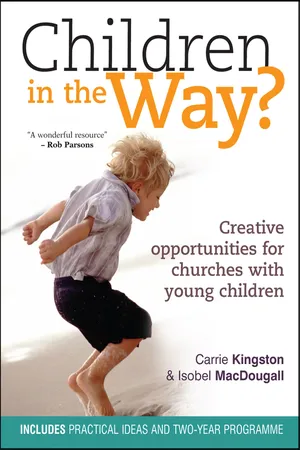
eBook - ePub
Children in the Way?
Creative opportunities for churches with young children
- 224 pages
- English
- ePUB (mobile friendly)
- Available on iOS & Android
eBook - ePub
Children in the Way?
Creative opportunities for churches with young children
About this book
The first years are critical, a pivotal time when children have powerful curiosity, exuberance for learning, and make strong connections through their experiences. This is also when a child's attitudes, values and perceptions are formed: 'Do I belong here?', 'Am I good enough?' Our grasp of how children learn has developed sharply in recent years. Nurseries and schools constantly review their approach, but churches frequently employ antiquated practices. Many alienate children because our methods don't meet their needs, and because we don't realise that some of the strongest messages are hidden. We are inoculating our children against church. The intention is to challenge churches about their children's work; to inform children's workers about the latest research; and to provide practical ideas. The authors suggest ways of providing relevant experiences and developing children's creativity, so that children's encounters with church is positive and enriching.
Frequently asked questions
Yes, you can cancel anytime from the Subscription tab in your account settings on the Perlego website. Your subscription will stay active until the end of your current billing period. Learn how to cancel your subscription.
At the moment all of our mobile-responsive ePub books are available to download via the app. Most of our PDFs are also available to download and we're working on making the final remaining ones downloadable now. Learn more here.
Perlego offers two plans: Essential and Complete
- Essential is ideal for learners and professionals who enjoy exploring a wide range of subjects. Access the Essential Library with 800,000+ trusted titles and best-sellers across business, personal growth, and the humanities. Includes unlimited reading time and Standard Read Aloud voice.
- Complete: Perfect for advanced learners and researchers needing full, unrestricted access. Unlock 1.4M+ books across hundreds of subjects, including academic and specialized titles. The Complete Plan also includes advanced features like Premium Read Aloud and Research Assistant.
We are an online textbook subscription service, where you can get access to an entire online library for less than the price of a single book per month. With over 1 million books across 1000+ topics, we’ve got you covered! Learn more here.
Look out for the read-aloud symbol on your next book to see if you can listen to it. The read-aloud tool reads text aloud for you, highlighting the text as it is being read. You can pause it, speed it up and slow it down. Learn more here.
Yes! You can use the Perlego app on both iOS or Android devices to read anytime, anywhere — even offline. Perfect for commutes or when you’re on the go.
Please note we cannot support devices running on iOS 13 and Android 7 or earlier. Learn more about using the app.
Please note we cannot support devices running on iOS 13 and Android 7 or earlier. Learn more about using the app.
Yes, you can access Children in the Way? by Carrie Kingston,Isobel MacDougall in PDF and/or ePUB format, as well as other popular books in Theology & Religion & Christian Ministry. We have over one million books available in our catalogue for you to explore.
Information
Ecclesiastes 3:1–11
A Time for Everything
There is a time for everything,
and a season for every activity under the heavens:
A time to be born and a time to die,
A time to plant and a time to uproot,
A time to kill and a time to heal,
A time to tear down and a time to build,
A time to weep and a time to laugh,
A time to mourn and a time to dance,
A time to scatter stones and a time to gather them,
A time to embrace and a time to refrain from embracing,
A time to search and a time to give up,
A time to keep and a time to throw away,
A time to tear and a time to mend,
A time to be silent and a time to speak,
A time to love and a time to hate,
A time for war and a time for peace…
…He has made everything beautiful in its time.
He has also set eternity in the human heart.

Section 1
Church Through a Child’s Eyes
This section will seek to explore aspects of church from a child’s perspective and will pose reflective questions. The main themes of the book will be introduced, including current scientific studies and how children learn. This section is rooted in Christian beliefs.
CHAPTER 1
Time Flies
Children’s church – what’s it for?
Isobel
In 1956, in a Sunday School in Sheffield, I remember standing singing “Somewhere beyond the blue, there’s a mansion for me…” I had no idea what it meant, and for years I wondered where “the blue” was. As for the mansion, I am still waiting for it to materialize! Sunday School was held every week at 3.00 p.m. to evangelize children and teach them about the Christian faith, and from an early age I went with my siblings.
Was this education or entertainment?
I would suggest it was neither, but it did occupy us for the afternoon and give our parents some respite; not that this was the intention.
Sunday Schools were originally started in Gloucester in 1780 by Robert Raikes to educate poor children from the factories. Children were taught from the Bible how to read and write, and developed their memory by learning passages of the Bible by heart. These children were working during the week, with no opportunity to attend school. Sunday Schools provided the opportunity for them to learn to read and write and also gave their parents, who were also working throughout the week, time to do their household chores and prepare for the next week. This was of course a time when many people in the UK attended church regularly, and social action was high on the agenda, so educating poor children was perceived as a valuable charitable act.
As time went on, and education for all children became compulsory, these afternoon Sunday Schools evolved to teach children about God and to evangelize children who were not from Christian families. When I was in Sunday School in Yorkshire in the 1950s, we used to go on marches through the town with a large banner, to recruit new members.
Sunday Schools gradually moved into the morning service and the tradition of children “going out” to their church groups developed. The expression “Sunday School” disappeared, to be replaced by more “user-friendly” terms, since the purpose of the “school” was no longer to educate children to read and write. These groups now tend to be for the children of families attending church. But has the ethos of a formal school lived on in our practice?
So, did my experience of Sunday School do me any harm?
Well, yes it did. It inoculated me against any interest in or enjoyment of church.
Of course, it wasn’t just Sunday School. Sitting through boring services in the morning added to my dislike of Sundays, a dislike which continued into adulthood, as I quickly found the content irrelevant to my own life and experience. Is it any surprise that teenagers have left the church in droves? What is there to hold their interest and attention?
Clearly times have changed. Very few churches hold an afternoon Sunday School. Children’s church is now an integral part of the life of the church. Or is it? Is it genuinely integral to the life of the church, or just an addition?
This book is designed for church leaders, leaders of children’s groups, children’s and youth workers in churches and anyone else who is interested in finding out more about the needs of very young children (i.e. from birth to seven years), and practical ways to work with them.
Some readers may belong to big churches where you have large groups of children and several teams of leaders. Others will belong to a smaller church and may have a few children across a wide age range and only one leader. Whatever your context, we hope that you will be able to find some helpful information, useful strategies and good resources which will support you in your work with children.
In 2010 I stayed on holiday in a medieval town in France with Evie, aged two years, and Niall, aged eight months. Evie was delighted with the clock tower at the end of the lane which struck the hour twice each hour, and the ancient church a few metres from our house. Every day Evie wanted to visit the church several times. As we entered the church she would tell me that we needed to be quiet, then she said that we could pray for mummy and daddy. As we went down the nave she would utter a small scream, which I would imitate, followed by a louder one and the exasperated comment, “It doesn’t do it, Granny.” I would reply, “No, it doesn’t have a good echo”.
Evie loves church. She attends most weeks with her parents and loves the singing and watching all the people and meeting up with friends. She attends crèche and loves it best when Daddy is there. She clearly sees church as a fun place to be where she can express herself. As she negotiated the new experience of the darkened church in France, with its candles and statues of saints, it was interesting that she was initially anxious and clung to me hard. She sensed the need for silence, but as the medieval church became more familiar to her on our repeated visits, she became more courageous and able to test the resonance of the building. Was it significant that the previous day she had been in the tunnel through the castle with her mother and they had listened for echoes?
At the age of two, Evie is an explorer, a scientist, an investigator of her world using all the knowledge she has acquired as well as her senses to develop the images in her brain, and repetition helps to make these brain connections strong.
Niall loved the church for a very different reason. He loved to crawl and pull himself up until he was standing on the pews. Using his thumbs to test out the texture and feel of objects and surfaces, he squealed with delight with his freedom to explore the church, freed from the restraints of the buggy! Niall used the senses he was born with to find out about his world. He was very sensitive to changing atmospheres as well as textures, temperatures, smells and sounds. Everything was tested by mouth. Niall is reliant on these senses and the mouth has many nerve endings which feed the brain with information – is the object hard, soft, smooth, rough, hot or cold? Is it edible?
In recent years, brain research has provided us with valuable information about very young children. We know that from their earliest moments...
Table of contents
- Cover
- Title Page
- Copyright Page
- Dedication
- Contents
- Acknowledgments
- Preface
- Ecclesiastes 3:1–11: A Time for Everything
- Section 1: Church Through a Child’s Eyes
- Section 2: So Last Sunday!
- Section 3: Small but Essential for Growth
- Section 4: Moving on Up!
- Section 5: Epilogue
- References